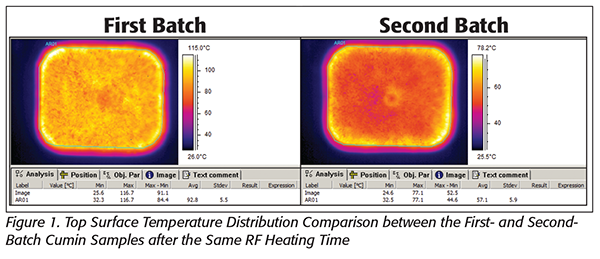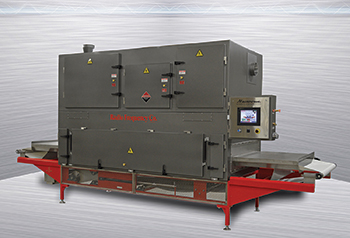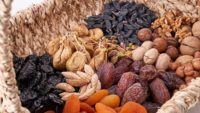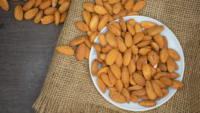According to the Food Safety Modernization Act regulations, any preventive microbial inactivation technology must be validated.[1] It is necessary to identify a suitable nonpathogenic surrogate with a similar or higher heat resistance than that of the target pathogen before thermal inactivation validation because pathogens cannot be used in food processing plants. The safety of low-moisture foods is becoming a major concern after several recent foodborne illness outbreaks.[2] The thermal resistance of bacteria in these foods creates major challenges in developing suitable food safety intervention technologies without deteriorating food quality.
Radiofrequency Heating
Radiofrequency (RF) heating involves utilizing electromagnetic energy at a frequency range of 3 kHz to 300 MHz. Only select RF frequencies (13.56, 27.12, and 40.68 MHz) are permitted for industrial, scientific, and medical applications.[3] RF is widely applied for sterilization/pasteurization,[4–10] thawing,[11,12] disinfestation,[13,14] and drying.[15] The heat is volumetrically generated by rotation and friction of ions and dipolar molecules in food products because of an alternating electrical field. The movement of positive and negative ions is ionic conduction, and rotation of dipolar molecules is dipole rotation.3 Ionic conduction and dipole rotation are the dominant mechanisms of RF heating.
Advantages of RF Heating
RF has a longer wavelength and penetration depth than those of microwaves. Thus, RF heating has advantages of more even electric field distribution and more uniform heating compared with microwave heating.[3] Its longer penetration depths make RF suitable for bulk sample treatment in the food industry. Since RF heating is volumetric, the whole sample can be heated rapidly. In conventional heating, the heat is transferred from the external surface to the internal center of the sample, resulting in longer come-up times to achieve the target temperature at the cold spot. To pasteurize egg white powder, for example, it is traditionally heat-treated by storing packaged product in a hot room at 58–60 °C for 10–14 days.[16] However, it took only 8 hours for RF-assisted processing to achieve pasteurization at 90 °C.[17] The shorter come-up time allows RF heating to be a high-temperature, short-time processing technology, which is more energy efficient and could retain more food quality after treatment. This is the major advantage of RF heating.
Because RF waves vibrate bound water,2 it is a suitable technology for low-moisture foods, such as spices and milk powder, which have more bound than free water.[2,18] RF systems can be turned on/off instantly for better process control. Since most food packages are plastic bags or cardboard boxes that are transparent to RF waves,[13] food products can be pasteurized after being packaged. Although heating uniformity is better in RF than in traditional thermal processing or microwaves, there is still room to improve heating uniformity in RF processing to achieve superior product quality.[3,19–21] Computer simulation is a powerful tool to understand RF heating and improve uniformity.[19–24] Therefore, RF heating has great potential to be applied for low-moisture food pasteurization in the food industry.
Critical Process Control Parameters
RF heating is influenced by many factors, such as the dielectric properties of food products, electrode gap, configurations of the top electrode and package, and top electrode voltage of a free-running oscillator with a two parallel-plate system. Dielectric properties of food products depend on moisture content (MC), frequency, temperature, density, and chemical composition.[3] Among these factors, MC is a major factor that affects the heating rate.[3] The dielectric constant represents a material’s ability to store the electric field energy, and the dielectric loss factor determines how much electromagnetic energy can be converted into heat.[25] Numerous researchers have measured the dielectric properties of different food products.[11,25–29] Top electrode voltage and electrode gap can regulate RF output power.[13,14] Electrical field strength determines the power output of a piece of equipment that impacts the heating rate. Very strong electrical field strength between two electrodes can cause arcing. The configurations of the top electrode and food package influence electric field distribution in the RF cavity, which can be optimized to improve heating uniformity.[22]
Microbial factors that must be considered for validation include the selection of strains, inoculation methods, stabilization, and equilibration time before treatment.[7] The thermal resistance of bacteria in low-moisture foods is a function of aw.30 Inoculation and stabilization methods for pathogens in low-moisture foods have a significant effect on pathogen survival of validated inactivation processes.[31] The bacterial culture is grown on a wet medium before inoculation onto dry products. When inoculated, bacteria may undergo stress due to a drastic change in environment. If not enough equilibration time is provided for bacteria to adapt to the low-moisture environment before processing, the processing technology may easily kill the bacteria as they are already stressed.[7] The results on the efficacy of intervention technologies may turn out to be very optimistic. In food safety validation studies, conservative estimates are critical to avoid potential recalls. Therefore, it is important to equilibrate the samples for several days for bacteria to adapt before performing process validation.[5,7,31] Thermal resistances of bacterial strains vary dramatically. To be efficient in running validation studies, several outbreak strains are mixed as a cocktail and then inoculated. While the results may not be attributed to any single strain, the results are representative of the most thermally resistant strain.
Case Study: RF Processing of Cumin Seeds
Spices are low-moisture foods that add flavor to foods as seasonings in different cuisines. However, their microbiological quality is a great concern because most spices are grown in countries without standard Western hygiene and sanitation conditions.[32] Cumin (Cuminum cyminum L.) is one of the most popular spices because of its distinctive flavor and aroma.33 Cumin seeds are susceptible to contamination with bacteria such as Escherichia coli, Salmonella, Clostridium perfringens, and Bacillus cereus because of cross-contamination with soil, water, and manure in the field, possibly causing public health risks and foodborne pathogen outbreaks.[34] Therefore, it is necessary to develop an efficient spice decontamination method to ensure food safety and maintain food quality.
 In one of our studies in RF processing of cumin seeds, we observed huge variations in heating rate and microbial inactivation when the two batches of samples were equilibrated to the same aw.[7] After the same RF heating time, the population of both Salmonella and Enterococcus faecium for the first batch of cumin seed was under the detection limit. But there were almost no log reductions of both bacteria for the second-batch sample. When analyzed, the moisture contents of the two batch samples were different due to variations in sample characteristics. Spices are imported from various countries and there is a huge variability in samples.[7] Thermal images of two batch samples clearly show the differences in heating rates (Figure 1). When conditioned to the same MC, the heating rate was similar and so also the microbial inactivation. We monitored cold-spot temperatures of both first- and second-batch samples and found that cold-spot temperatures were similar when achieving more than 5-log reduction of Salmonella. The cold spot of the third-batch sample with the same MC was heated to the same cold-spot temperature of the previous two batches, and a 5-log reduction was achieved as expected. Therefore, cold-spot temperature and MC are two critical process control parameters in RF processing. These two parameters must be monitored in the food industry as Critical Control Points when this novel technology is deployed as a microbial intervention technology.
In one of our studies in RF processing of cumin seeds, we observed huge variations in heating rate and microbial inactivation when the two batches of samples were equilibrated to the same aw.[7] After the same RF heating time, the population of both Salmonella and Enterococcus faecium for the first batch of cumin seed was under the detection limit. But there were almost no log reductions of both bacteria for the second-batch sample. When analyzed, the moisture contents of the two batch samples were different due to variations in sample characteristics. Spices are imported from various countries and there is a huge variability in samples.[7] Thermal images of two batch samples clearly show the differences in heating rates (Figure 1). When conditioned to the same MC, the heating rate was similar and so also the microbial inactivation. We monitored cold-spot temperatures of both first- and second-batch samples and found that cold-spot temperatures were similar when achieving more than 5-log reduction of Salmonella. The cold spot of the third-batch sample with the same MC was heated to the same cold-spot temperature of the previous two batches, and a 5-log reduction was achieved as expected. Therefore, cold-spot temperature and MC are two critical process control parameters in RF processing. These two parameters must be monitored in the food industry as Critical Control Points when this novel technology is deployed as a microbial intervention technology.
After the same RF heating time under the same treatment conditions, E. faecium always showed a lower log reduction than that of Salmonella. Therefore, we can conclude that E. faecium is a good surrogate for Salmonella cocktail strains in cumin seeds for RF processing.[7]
Long Chen is a doctoral student in the Department of Biological Systems Engineering at the University of Nebraska–Lincoln.
Jeyamkondan Subbiah, Ph.D., P.E., is the Kenneth E. Morrison Distinguished Professor of Food Engineering in Biological Systems Engineering and Food Science & Technology at the University of Nebraska–Lincoln.
References
1. U.S. Food and Drug Administration. 2015. “Current Good Manufacturing Practice, Hazard Analysis, and Risk-Based Preventive Controls for Human Food.” Fed Regist 80:55908–56168.
2. www.food-safety.com/magazine-archive1/junejuly-2017/radio-frequency-heating-for-low-moisture-foods/.
3. Marra, F, et al. 2009. “Radio Frequency Treatment of Foods: Review of Recent Advances.” J Food Eng 91(4):497–508.
4. Liu, S, et al. 2018. “Microbial Validation of Radio Frequency Pasteurization of Wheat Flour by Inoculated Pack Studies.” J Food Eng 217:68–74.
5. Wei, X, et al. 2018. “Radio-Frequency Processing for Inactivation of Salmonella enterica and Enterococcus faecium NRRL B-2354 in Black Peppercorn.” J Food Prot 81(10):1685–1695.
6. Li, R, et al. 2017. “Verification of Radio Frequency Pasteurization Process for In-Shell Almonds.” J Food Eng 192:103–110.
7. Chen, L, et al. 2019. “Inactivation of Salmonella enterica and Enterococcus faecium NRRL B-2354 in Cumin Seeds by Radiofrequency Heating.” Food Control (in review).
8. Hu, S, et al. 2018. “Inactivation Kinetics for Salmonella Typhimurium In Red Pepper Powders Treated by Radio Frequency Heating.” Food Control 85:437–442.
9. Kim, SY, et al. 2012. “Radio-frequency Heating to Inactivate Salmonella Typhimurium and Escherichia coli O157:H7 on Black and Red Pepper Spice.” Int J Food Microbiol 153(1-2):171–175.
10. Jeong, SG and DH Kang 2014. “Influence of Moisture Content on Inactivation of Escherichia coli O157:H7 and Salmonella enterica Serovar Typhimurium in Powdered Red and Black Pepper Spices by Radio-frequency Heating.” Int J Food Microbiol 176:15–22.
11. Bedane, TF, et al. 2017. “Experimental Study of Radio Frequency (RF) Thawing of Foods with Movement on Conveyor Belt.” J Food Eng 201:17–25.
12. Li, Y, et al. 2018. “Radio Frequency Tempering Uniformity Investigation of Frozen Beef with Various Shapes and Sizes.” Innov Food Sci Emerg Technol 48:42–55.
13. Huang, Z, et al. 2015. “Computer Simulation of Radio Frequency Selective Heating of Insects in Soybeans.” Int J Heat Mass Transfer 90:406–417.
14. Birla, S, et al. 2004. “Improving Heating Uniformity of Fresh Fruit in Radio Frequency Treatments for Pest Control.” Postharvest Biol Tec 33(2):205–217.
15. Zhang, B, et al. 2016. “Developing Hot Air-Assisted Radio Frequency Drying for In-Shell Walnuts.” Emir J Food Agr 28(7):459–467.
16. Handa A, et al. 2001. “Correlation of the Protein Structure and Gelling Properties in Dried Egg White Products.” J Agric Food Chem 49(8):3957–3964.
17. Boreddy, SR, et al. 2016. “Novel Radiofrequency Assisted Thermal Processing Improves the Gelling Properties of Standard Egg White Powder.” J Food Sci 81(3):E665–E671.
18. Awuah, GB, et al. Radio-Frequency Heating in Food Processing (Boca Raton, FL: CRC Press, Taylor & Francis Group, 2015).
19. Chen, L, et al. 2015. “A Strategy to Simulate Radio Frequency Heating under Mixing Conditions.” Comput Electron Agr 118:100–110.
20. Chen, L., et al. 2016. “Simulation and Validation of Radio Frequency Heating with Conveyor Movement.” J Electromagnet Wave 30(4):473–491.
21. Chen, J, et al. 2017. “Modeling Radio Frequency Heating of Food Moving on a Conveyor Belt.” Food Bioprod Process 102:307–319.
22. Tiwari, G, et al. 2011. “Computer Simulation Model Development and Validation for Radio Frequency (RF) Heating of Dry Food Materials.” J Food Eng 105(1):48–55.
23. Jiao, Y, et al. 2015. “Improvement of Radio Frequency (RF) Heating Uniformity on Low Moisture Foods with Polyetherimide (PEI) Blocks.” Food Res Int 74:106–114.
24. Zhu, H, et al. 2017. “A Novel Method to Improve Heating Uniformity in Mid-High Moisture Potato Starch with Radio Frequency Assisted Treatment.” J Food Eng 206:23–36.
25. Zhang, S, et al. 2016. “Dielectric Properties of Peanut Kernels Associated with Microwave and Radio Frequency Drying.” Biosyst Eng 145:108–117.
26. Ling, B, et al. 2015. “Dielectric Properties of Pistachio Kernels as Influenced by Frequency, Temperature, Moisture and Salt Content.” Food Bioprocess Tech 8(2):420–430.
27. Ozturk, S, et al. 2016. “Dielectric Properties of Dried Vegetable Powders and Their Temperature Profile during Radio Frequency Heating.” J Food Eng 169:91–100.
28. Boreddy, SR and J Subbiah. 2016. “Temperature and Moisture Dependent Dielectric Properties of Egg White Powder.” J Food Eng 168:60–67.
29. Nelson, SO. 1991. “Dielectric Properties of Agricultural Products—Measurements and Applications.” IEEE Trans Electr Insul 26(5):845–869.
30. Syamaladevi, RM, et al. 2016. “Water Activity Change at Elevated Temperatures and Thermal Resistance of Salmonella in All Purpose Wheat Flour and Peanut Butter.” Food Res Int 81:163–170.
31. Bowman, LS, et al. 2015. “Inoculation Preparation Affects Survival of Salmonella enterica on Whole Black Peppercorns and Cumin Seeds Stored at Low Water Activity.” J Food Prot 78(7):1259–1265.
32. Farakos, SMS and JF Frank. “Challenges in the Control of Foodborne Pathogens in Low-Water Activity Foods and Spices,” in The Microbiological Safety of Low Water Activity Foods and Spices (New York: Springer, 2014), 15–34.
33. Mathew AG and S Pushpanath. Indian Spices (India: Dee Bee Info Publications, 2005).
34. Al-Jassir, MS. 1992. “Chemical Composition and Microflora of Black Cumin (Nigella sativa L.) Seeds Growing in Saudi Arabia.” Food Chem 45(4):239–242.

 Today, RFC’s Macrowave™ pasteurization systems are treating more than 500 million pounds of food ingredients, both for humans and pets, per year. Unlike irradiation and other treatment methods, RF treatment is certified organic, natural, and can be used on an FDA-approved clean label. In an RF pasteurization system, the RF generator creates an alternating electric field between two electrodes, above and below the system conveyor, which causes the treated product to heat rapidly and uniformly throughout its entire thickness, whether it is processed in bags, or in bulk on a troughed conveyor. This rapid and volumetric heating means that there is no temperature differential from the surface to the center of a product and no prolonged soak time that can damage functionality and other organoleptic qualities. All Macrowave systems meet FSMA standards for a preventive control step and incorporate the HACCP monitoring, data logging, and alarm functionality required for a kill-step validation. Treatment systems are available in a broad range of sizes to suit individual customer requirements and are designed and constructed to GMP standards for food safety and ease of sanitation. All Macrowave systems are UL approved, FCC certified, and EU compliant. For all systems deployed domestically or internationally, RFC maintains a complete spare parts inventory; factory-trained RF service technicians are available 24/7. RFC’s MacroCare Preventive Service Plan assures customers that their system is operating at peak performance, minimizing downtime and maximizing their ROI. Because RF treatment is a USDA Organic thermal process and is easy to own and operate, it’s no wonder why RFC’s Macrowave pasteurization systems are truly “the wave of the future” in food safety.
Today, RFC’s Macrowave™ pasteurization systems are treating more than 500 million pounds of food ingredients, both for humans and pets, per year. Unlike irradiation and other treatment methods, RF treatment is certified organic, natural, and can be used on an FDA-approved clean label. In an RF pasteurization system, the RF generator creates an alternating electric field between two electrodes, above and below the system conveyor, which causes the treated product to heat rapidly and uniformly throughout its entire thickness, whether it is processed in bags, or in bulk on a troughed conveyor. This rapid and volumetric heating means that there is no temperature differential from the surface to the center of a product and no prolonged soak time that can damage functionality and other organoleptic qualities. All Macrowave systems meet FSMA standards for a preventive control step and incorporate the HACCP monitoring, data logging, and alarm functionality required for a kill-step validation. Treatment systems are available in a broad range of sizes to suit individual customer requirements and are designed and constructed to GMP standards for food safety and ease of sanitation. All Macrowave systems are UL approved, FCC certified, and EU compliant. For all systems deployed domestically or internationally, RFC maintains a complete spare parts inventory; factory-trained RF service technicians are available 24/7. RFC’s MacroCare Preventive Service Plan assures customers that their system is operating at peak performance, minimizing downtime and maximizing their ROI. Because RF treatment is a USDA Organic thermal process and is easy to own and operate, it’s no wonder why RFC’s Macrowave pasteurization systems are truly “the wave of the future” in food safety. 


